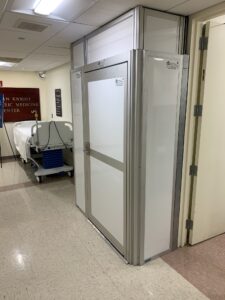What You Need to Know About the use of Anterooms in Hospitals

Let’s talk about Anterooms in Hospitals and the unprecedented situation that we’re facing which has brought along many new challenges for all of us. As we learn to navigate through these trying times together, we all share a responsibility to protect ourselves and protect our community. Hospitals and healthcare facilities are facing even greater challenges to be able to safely care for their patients.
The unique nature of this particular virus requires extreme preventative measures in order to prevent the spread of the illness throughout the facility. It is essential for hospitals to take the necessary precautions to protect their patients and staff. In addition to wearing PPE and following the recommendations provided by the CDC, many hospitals have been using anterooms as part of the facility’s infection control strategy.
If you’re not familiar with anterooms and their benefits, we’re here to answer your questions:
- What are they?
- When should they be used?
- What configuration should be used… and more!
Keeping reading to learn the value of anterooms, and how our team at Temporary Wall Systems can provide you with installations that help to slow the spread of COVID-19.
What is an Anteroom?
By definition, an anteroom -or ante room – is a small room or entryway that one would enter and leads to a larger area. They can be permanent or temporary, depending on their function.
When to Use One?
The anteroom is often used during hospital renovations and maintenance, as they contain dust and debris and prevent patients from contracting Hospital Acquired Infections (HAIs). In addition to the purpose they serve during construction, they’re also used to provide infection control during a public health crisis.
They can also be used as isolation rooms to help prevent the spread of infectious diseases, such as the current COVID-19 pandemic. They have become an essential tool to control contaminated air, as they create a negative air barrier to separate infected areas with other treatment spaces.
The Value of Anterooms
Many hospitals have found value in installing anterooms in their facilities in order to provide an extra layer of protection for patients and staff. Utilizing them in areas where COVID-19 patients are being treated can be an effective strategy for slowing the spread of this infectious virus. The small space is effective in controlling contaminated air and the airflow between infected patients and other treatment areas in the hospital.
How to Pick The Right Configuration?
If you do choose to use an anteroom for infection control, it’s imperative that the materials used for configuration meet the necessary requirements.
We exclusively use Temporary Wall Systems panels, as they exceed ICRA IV requirements and provide airtight containment. Our products are also durable, sound attenuating, and visually appealing to maintain the professional appearance of the facility.
Do They Take Long to Install?
When you choose to install an anteroom, it’s likely an urgent situation, and therefore crucial that the installation process is quick and efficient. It only takes a few hours to properly install one using Temporary Wall Systems panels! At Temporary Wall Systems LLC, our rapid response team is always ready to assist you.
We’re a full-service company, meaning that we rent, install, mobilize, and remove the panels when it is time to do so. This makes it an easy and seamless process, with minimal disruption at all to the operations of your facility. We’ve completed several anteroom installations during this time with just 24 hours’ notice.
Elliot Hospital, Winchester Hospital, South Shore Hospital, and UMass Memorial Hospital are among the several healthcare facilities that have taken advantage of our modular containment services as part of their proactive approach to preventing the spread of COVID-19.
Contact Temporary Wall Systems, LLC. for Anteroom Installation
If you’re interested in learning more about the value of anterooms or any of our other containment solutions for hospitals during this time, get in contact with us today! We can also provide isolation rooms, hallway containment, and beyond. Together, we can get COVID-19 contained!


